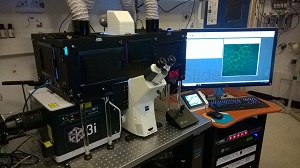3I Spinning Disc Confocal
Spinning disc confocal microscope
Description
Location: Room 1.12, MRC Building
Advantages: Speed, resolution, variety of laser lines, wide field of view, improved clarity of thick samples, flexible photo-bleaching and photo-activation
Disadvantages: Lower sensitivity;
The 3i is a spinning disc confocal microscope designed for rapid acquisition of 3D and 4D data. The microscope consists of a Zeiss AxioObserver Z1 inverted stand attached to a Yokogawa CSU-W1 spinning disc scan head. There are two cameras on the system, a Photometrics Prime BSI Scientific CMOS and a Photometrics Prime 95B Scientific CMOS. The Prime BSI has smaller pixels for higher resolution, and the 95B has larger pixels for higher sensitivity. The Z1 stand includes Zeiss' Definite Focus system, which can maintain samples in focus indefinitely. This is most suitable for samples mounted at a glass/aqueous interface but there are some exceptions. Please check specimen and objective lens compatibility before using the autofocus. The Vox also has a photomanipulation unit for spot or ROI illumination in techniques such as FRAP and photo-activation/photo-switching.
Suitable specimens: All culture vessels must have glass bottoms with the same thickness as a standard #1.5 cover-slip (170 µm). There are inserts for slides, Ibidi µSlides, Lab-Tek chambered cover slips (note - use Lab-Tek I not Lab-Tek II), 35 mm dishes, multi-well plates. If you have any other requirements then you must speak to a member of the light microscopy facility before you start preparing your specimen.
In general spinning disc confocal systems perform optimally with adherent cells in culture and other relatively thin specimens. Thicker specimens with a large amount of out-of-focus fluorescence can be difficult to image because of a phenomenon called pinhole crosstalk. The CSU-W1 has a an additional 25µm spinning disk for use with thicker samples at lower magnification.
